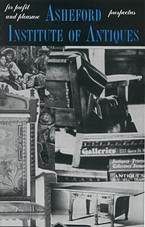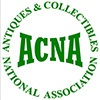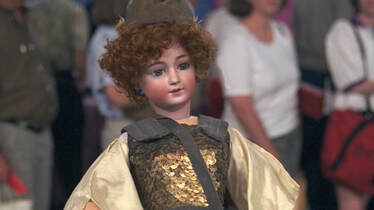 Pennsylvania - Just like the popular PBS television series, This Old House, it would seem that people, no matter what the subject, will always have questions surrounding the topic of things that are old - whether it's a house, piece of furniture or even a doll. However, when it comes to collectible dolls, this statement is usually followed up with the classic value refrain of, "I have an old doll... BUT, can you also tell me what it's worth?" As a doll collector, appraiser, and restorer, questions of age and value are usually the most common queries to hit my inbox on a daily basis. While there's often no simple textbook answer to most of these questions, there are a few important consideration points I like to suggest to individuals before proceeding with any kind of response. Often, when prospective clients reach out to me with statements regarding age and value, terminology clarification is usually required. For example, the term old has several meanings, which may or may not be what a client has in mind when first positing a question. Old, as defined by Merriam-Webster is something dating from the remote past (ancient), or persisting from an earlier time. However, old is also defined as having existed for a specified period of time; of, relating to, or originating in a past era; being advanced in years or age. Once I'm able to convey the range of possibilities that can come with the use of such terms, I'm often in a much better position to be able to formulate a clearer and more precise response to clients initial queries, since we're now sharing a mutual understanding of the terminology being used, as well as any implied meanings that may exist outside the scope of traditional definitions. In the world of doll collecting, there are several 'age' categories to consider. These include: antique, vintage, contemporary and modern. Understanding the differences and nuances between these categories can often be confusing to individuals and even some novice collectors, as many simply lump the entirety into the classification of old. Determining what separates these categories is key when it comes to understanding the concept of value and worth. Antique dolls are those that existed prior to a hundred years from today's date (i.e. a doll produced before 1919). Dolls from this period were most often made of bisque or biscuit porcelain. These dolls would often have bodies made from materials such as kid or unbleached muslin filled with sawdust or horsehair, or bodies whittled from wood, pressed wood composite, or celluloid (Note: celluloid nitrate, alcohol, camphor pigments, and similar fillers are materials manufacturers would not use today). Other materials that were used for bodies during this period included wax over bisque, wax over papier mache, and even corncobs. Vintage dolls are those which were created within the last seventy-five to ninety-nine years. Most of the bodies were made of similar materials as those used in antique dolls, with a few notable differences. Substances that are akin to vintage and modern dolls would include such materials as, hard plastics, vinyl, and magic skin (latex/vinyl with the texture of a balloon stuffed with a padding fabric). 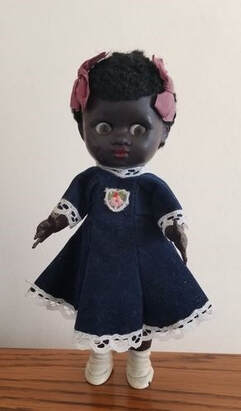 Pedigree, England. Circa, 1950 Pedigree, England. Circa, 1950 In truth, most individuals who come to me with a question of worth and value, usually have the latter category of doll in hand when arriving for an assessment (and that's usually what I end up telling them), especially after we've finished having the "what is old" discussion. It may not always be what they want to hear, but nine times out of ten, it's usually the case. So in the end, what is it that really determines a dolls worth and value? As with most other things in the decorative arts market, it comes down to a few simple factors - just as most antique and vintage items are based on rarity, condition, manufacturer, and current popularity with regard to sales - so are dolls. However, with that being said, dolls can sometimes fall outside the purview of mainstream evaluation techniques when buyers and sellers both have a vested sentimental interest in the item being offered up for sale. While this condition usually forces up the selling price, and can also exist in traditional antique sales, my experience has shown it to be far more prevalent when it comes to dolls exchanging hands.  Valarie Moyer AIA, PACC, is an Asheford honors graduate, an alumni of Columbia Southern University, and a passionate writer and preservationist of antique and vintage dolls. When not working as an author, speaker and member of the United Federation of Doll Clubs, you'll often find her tending to her clients at Unique Dolls & Gifts Doll Hospital in Jonestown, Pennsylvania 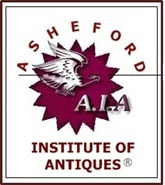 NOTE: For readers seeking more information about the Asheford Institute Of Antiques distance-learning program on professional-level appraising, the study of antiques, collectibles, vintage and mid-century modern items, please click here to visit the school's Home Page. Should you have additional questions about the Asheford program, you can also write to the school at: [email protected] or call the Registrar's Office toll-free at: 1-877-444-4508 Comments are closed.
|
AIA StaffWe're providing our students and reader's with the latest breaking news on events and happenings that we think might be of interest to both collectors and dealers alike. Including changes within the world of antiques, vintage, collectibles and appraising that might just have an effect on your bottom line. We're also interested in hearing from you - so if you've got a great newsworthy story, let us know, and you just might find it here! Archives
July 2024
CategoriesLegal Disclaimer: Extraneous opinions, statements and comments made by individuals represented within these posts do not necessarily reflect those of the Institute. The publication naming of specific business entities, organizations, and concerns, contained herein, in no way represents an endorsement or recommendation of services or products by the Institute. Publicly identifiable information contained herein (including, but not limited to contact information), has been intentionally limited where possible, due to privacy and legal concerns related to the digital dissemination of information through online means. All views expressed herein are those of their respective owners. The Institute is in no way responsible, financially or otherwise, for the accuracy or validity of statements contained within published posts from sources that originate and appear outside of the written and expressed views of those submitted by the Institute.
|
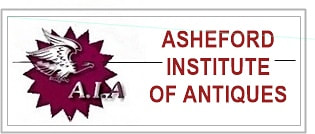
 RSS Feed
RSS Feed
